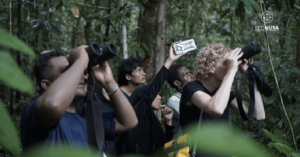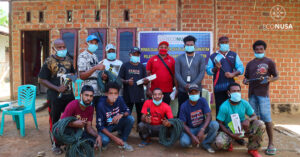
License revocation of four palm oil companies in Sorong Regency, West Papua, spreads out in 9 Districts, namely Segun, Salawati, Malabotom, Klamono, Mariat, Mayamuk, Sayosa, Konhir, and Wemak. The locations of villages with the formerly revoked concession are located at the expanse of natural forests areas.
The rich natural resources of those locations should be well-managed for the benefit of people’s welfare. To ensure the process, EcoNusa strengthens the capacity of indigenous people in terms of their potentials management. This is done, among others, by conducting a scoping to ensure that a village has commitment to defend their natural resources. The scoping covered 9 villages in 4 Districts. Those villages were Gisim, Klajaring, Segun, and Malamas in Segun District, Kasimile, Walio, and Klayas Villages in Seget District, Mamsit in Botain District, and Ningjemur Village in Moisegen District, in Sorong Regency.
One of the 9 villages, Gisim, is located at Segun District, Sorong Regency. The Village is inhabited by Moi Tribe, of Moi Segin subtribe. Gisim was formerly called Seremuk Wala Village populated by 9 clans of Moi Segin subtribe, namely Klafiyu, Kayaur, Sede, Klasi, Klawon, Malaum, Yau, Kalami, and Malasmene clans. The nine clans here live in peaceful ambience and work collaboratively for church, tradition, and other governmental-related affairs.
Read Also: Sago, Vegetation with Loads of Benefit Threatened by Development
Access to Gisim is by long boat through sea from Modan in Moisegin District. It usually takes 2-4 hours trip by river or the dense mangrove forests. Due to the faraway access from public mobilization, the origin culture of Moi Tribe in Gisim Village looks natural. Most villagers still eat sago (papeda). The local women still have traditional skills and knowledge. Many women make noken, waive mat, koba-koba (woven mat from forest pandanus leave).
The traditional mat or koba-koba is used for sleeping and serves as an umbrella in the rain or hot days. Besides, many of the locals use koba-koba as the tool to keep important documents. All stuffs based on the local knowledge here has profound philosophy. Koba-koba has assorted size. The large size usually is 150×75 centimeters, the medium size 50-70 centimeters which is commonly used as a folder. The small one is usually 10-15 centimeters in size and used as a purse.
Moi Tribe community in Gisim Village has remarkable natural potentials. They have shrimp, fish, crab, deer, pig, ironwood, rattan rope, cempedak and langsat fruits as the local potentials. The potentials here could become the promising sources for livelihood. Even, when it is converted into rupiah value, the community of Moi Tribe could earn up to hundred million rupiahs each month.
Read Also: Sanggase, Vying to be Rice Producer in Okaba District
Despite the local wisdom, the locals are still waiting for motivation and capacity building so that they have more ability to identify and get the benefits of their potentials. Actually, the indigenous peoples of Gisim have their own hopes and dreams for their own management of the existing sources of life.
However, they in fact face transportation problem. This obstacle has become the major reason for the locals to not manage the existing natural potentials. According to Ana Kayaru, a local woman of Gisim, said that they had once participated in a training provided by Papua University to process sago flour, banana-made crackers, deer-based jerked meat, and various fish-based food.
Unluckily, following the training, they got less attention. “If we process them into derivative products, we wonder where to sell them. Not all of us has boat and boat engine,” said Ana. She told that in Gisim Village, there is no fuel station for community transportation.
The condition has made the locals shiftless and preferred to stay still despite the existing potentials. They just took the natural resources for their consumption. “We just stay idle after training. We do not continue the process,” Ana added.
Read Also: Pili Nut, Shade Tree as the Source of Livelihood
To meet their daily needs such as salt, soap, sugar, coffee, and cooking oil, the people in Gisim sometimes sell their caught animal such as deer meat, to a middleman or kiosk. The middleman purchases the raw deer meat Rp45,000 per kilogram, red snapper Rp15,000-20,000 per kilogram. The locals earn income from the sale to pay their children school tuition or other domestic needs.
To help identify the local potential, EcoNusa conducted a scooping as a way of mapping the villages and their local potentials through Social Transformation School (STS). The STS is deemed the form of indigenous community development that allows them to identify and develop their natural and human resources. “We as villagers hope that EcoNusa Foundation as the partner could help connect and improve our earnings particularly for the economic independence with sustainable nature,” said Nomensen Kayaru, the secretary of Gisim Village.
Most of the community survive from domestic farming such as sago, taro, and vegetables, from forest products such as timer, and hunted animals like boar, deer, fish, shrimp. Farming is still done by nomadic agriculture. They have not known planting pattern and farming system. Most of the community sells the forests and farming products as raw materials. None has processed those products from farming, forests, sea, or river. If only they could process their potentials, it will give them more added value than selling raw materials.
Editor: Leo Wahyudi







